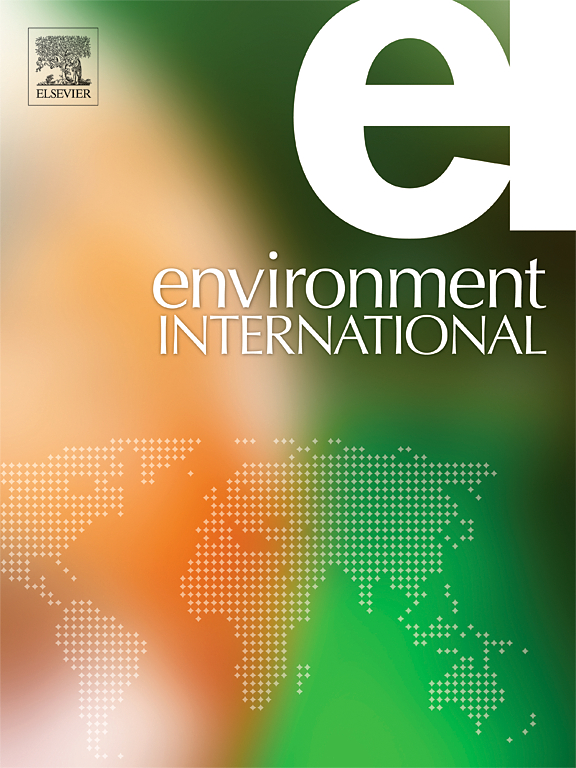Associations of prenatal glyphosate exposure with child neurodevelopment in a Canadian pregnancy cohort study
IF 10.3
1区 环境科学与生态学
Q1 ENVIRONMENTAL SCIENCES
引用次数: 0
Abstract
Objective
Glyphosate is the most widely used pesticide worldwide. Few epidemiologic studies have examined the potential for neurotoxicity by glyphosate or its degradate, Aminomethylphosphonic Acid (AMPA). We examined associations of maternal urinary glyphosate and AMPA concentrations with child cognitive, social, and behavioural functioning in participants enrolled in the Maternal-Infant Research on Environmental Chemicals (MIREC) study.
Methods
Maternal urinary glyphosate and AMPA concentrations were measured in first trimester spot urine samples. We assessed children’s cognition (IQ) at 3−4 years of age (n = 572) using the Wechsler Preschool and Primary Scale of Intelligence-III. Social (n = 566) and behavioural (n = 840) functioning were assessed using parent-report versions of the Social Responsiveness Scale-2 and Behavioral Assessment System for Children-2. We quantified associations between maternal urinary glyphosate and AMPA concentrations and child neurodevelopmental outcomes using multivariable linear regression models and assessed effect modification by child sex, maternal folic acid, and plasma folate.
Results
Median (IQR) urinary glyphosate and AMPA concentrations were 0.31 (0.33) μg/L and 0.25 (0.25) μg/L. Maternal urinary glyphosate and AMPA concentrations were not significantly associated with children’s cognitive, social or behavioural functioning, and there was no evidence of effect modification. We found a non-significant inverse trend between maternal urinary AMPA concentrations and Performance IQ (B = -0.85; 95 %CI: −1.71,0.01).
Conclusion
In this primarily urban cohort of Canadian mother–child pairs, prenatal glyphosate and AMPA exposure were not significantly associated with child neurodevelopment. Further evaluation of glyphosate as a potential developmental neurotoxicant in a study with multiple urine samples per participant and at higher exposure levels is warranted.
加拿大妊娠队列研究中产前草甘膦暴露与儿童神经发育的关系
目的草甘膦是全球使用最广泛的杀虫剂。很少有流行病学研究对草甘膦或其降解产物氨甲基膦酸(AMPA)的潜在神经毒性进行研究。我们研究了母婴环境化学品研究(MIREC)参与者中母体尿液草甘膦和 AMPA 浓度与儿童认知、社交和行为功能的关系。我们使用韦氏学前和小学智力量表-III 评估了 3-4 岁儿童(572 人)的认知能力(IQ)。社交(566 人)和行为(840 人)功能采用家长报告版的社会反应量表-2 和儿童行为评估系统-2 进行评估。我们使用多变量线性回归模型量化了母体尿液中草甘膦和AMPA浓度与儿童神经发育结果之间的关联,并评估了儿童性别、母体叶酸和血浆叶酸对影响的修饰作用。结果尿液中草甘膦和AMPA浓度的中位数(IQR)分别为0.31 (0.33) μg/L和0.25 (0.25) μg/L。母亲尿液中草甘膦和 AMPA 的浓度与儿童的认知、社会或行为功能没有显著相关性,也没有证据表明存在效应修正。我们发现,母体尿液中的 AMPA 浓度与智商表现呈非显著的反向趋势(B = -0.85;95 %CI:-1.71,0.01)。有必要在一项研究中对草甘膦作为一种潜在的发育神经毒物进行进一步评估,这项研究将为每名参与者采集多个尿样,并且暴露水平更高。
本文章由计算机程序翻译,如有差异,请以英文原文为准。
求助全文
约1分钟内获得全文
求助全文
来源期刊

Environment International
环境科学-环境科学
CiteScore
21.90
自引率
3.40%
发文量
734
审稿时长
2.8 months
期刊介绍:
Environmental Health publishes manuscripts focusing on critical aspects of environmental and occupational medicine, including studies in toxicology and epidemiology, to illuminate the human health implications of exposure to environmental hazards. The journal adopts an open-access model and practices open peer review.
It caters to scientists and practitioners across all environmental science domains, directly or indirectly impacting human health and well-being. With a commitment to enhancing the prevention of environmentally-related health risks, Environmental Health serves as a public health journal for the community and scientists engaged in matters of public health significance concerning the environment.
 求助内容:
求助内容: 应助结果提醒方式:
应助结果提醒方式:


